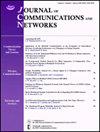Green behavior diffusion with positive and negative information in time-varying multiplex networks
IF 3.2
3区 计算机科学
Q2 COMPUTER SCIENCE, INFORMATION SYSTEMS
引用次数: 0
Abstract
How to comprehend the relationship between information spreading and individual behavior adoption is an essential problem in complex networks. To this end, a novel two-layer model to depict the diffusion of green behavior under the impact of positive and negative information is proposed. Positive information motivates people to adopt green behavior, while negative information reduces the adoption of green behavior. In the model, the physical contact layer describes the green behavior diffusion, and the information layer describes the positive and negative information spreading. Moreover, the social interactions of individuals in two layers change with time and are illustrated by an activity-driven model. Then, we develop the probability transition equations and derive the green behavior threshold. Next, experiments are carried out to confirm the preciseness and theoretical predictions of the new model. It reveals that the prevalence of green behavior can be promoted by restraining the negative information transmission rate and recovery rate of the green nodes while facilitating the positive information transmission rate and green behavior transmission rate. Additionally, reducing the positive information recovery rate and the recovery rate of the green nodes, and increasing the rates of forgetting negative information are beneficial for encouraging the outbreak of green behavior. Furthermore, in the physical contact layer, higher contact capacity and greater activity heterogeneity significantly facilitate green behavior spreading. In the information layer, smaller contact capacity and weaker activity heterogeneity promote diffusion when negative information dominates, whereas larger contact capacity and stronger activity heterogeneity are beneficial when positive information prevails.时变多路网络中正负信息的绿色行为扩散
如何理解信息传播与个体行为采用之间的关系是复杂网络中的一个重要问题。为此,本文提出了一种新的两层模型来描述正面和负面信息影响下的绿色行为扩散。积极信息会促使人们采取绿色行为,而消极信息会减少人们采取绿色行为。在模型中,物理接触层描述绿色行为扩散,信息层描述正负信息扩散。此外,两层个体的社会互动随时间而变化,并通过活动驱动模型来说明。然后,我们建立了概率转移方程,并推导出绿色行为阈值。接下来,通过实验验证了新模型的准确性和理论预测。研究发现,通过抑制绿色节点的负向信息传送率和恢复率,促进正向信息传送率和绿色行为传送率,可以促进绿色行为的流行。此外,降低正信息的恢复率和绿色节点的恢复率,提高负面信息的遗忘率,有利于促进绿色行为的爆发。此外,在物理接触层,更高的接触容量和更大的活动异质性显著促进了绿色行为的传播。在信息层中,当负面信息占主导地位时,较小的接触容量和较弱的活动异质性有利于扩散,而当正面信息占主导地位时,较大的接触容量和较强的活动异质性则有利于扩散。
本文章由计算机程序翻译,如有差异,请以英文原文为准。
求助全文
约1分钟内获得全文
求助全文
来源期刊
CiteScore
6.60
自引率
5.60%
发文量
66
审稿时长
14.4 months
期刊介绍:
The JOURNAL OF COMMUNICATIONS AND NETWORKS is published six times per year, and is committed to publishing high-quality papers that advance the state-of-the-art and practical applications of communications and information networks. Theoretical research contributions presenting new techniques, concepts, or analyses, applied contributions reporting on experiences and experiments, and tutorial expositions of permanent reference value are welcome. The subjects covered by this journal include all topics in communication theory and techniques, communication systems, and information networks. COMMUNICATION THEORY AND SYSTEMS WIRELESS COMMUNICATIONS NETWORKS AND SERVICES.

 求助内容:
求助内容: 应助结果提醒方式:
应助结果提醒方式:


